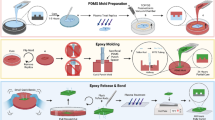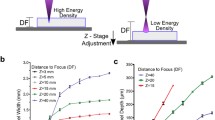Abstract
This article describes the fabrication of microfluidic networks (μFNs) from a commercially available (styrene)–(ethylene/butylene)–(styrene) (SEBS) block copolymer (BCP). The unique combination of hard and elastomeric properties provided by this material promotes high-throughput replication of fluidic structures using thermoforming technologies, while retaining the advantage of quick and easy assembly via conformal contact, as commonly achieved for devices fabricated from poly(dimethylsiloxane (PDMS). We employ Versaflex CL30, which is optically transparent, available at low cost (e.g., $2.50/Lbs), and likely to be compatible with a broad range of biological species. We demonstrate excellent fidelity in replication of fluidic structures using hot embossing lithography in conjunction with a photolithographically prepared Si/SU-8 master mold. Moreover, we introduce rapid prototyping of high-quality structures using an approach that we call soft thermoplastic lithography (STPL). Thanks to the rheological characteristics of the SEBS copolymer, STPL enables thermoforming on a heated master at temperatures around 170°C. Using this approach, replication can be completed within a very short period of time (e.g., less than 3 min) without the need of resorting to pressure- or vacuum-assisted instrumentation. Serving as a proof-of-concept, we devise a μFN that is suitable for the formation of miniaturized arrays comprising fluorescently labeled oligonucleotides and proteins on hard plastic substrates. Resultant spots are characterized by high fluorescent contrast, excellent edge definition, and uniform distribution of probes within the modified areas.







Similar content being viewed by others
References
Benn JA, Hu J, Hogan BJ, Fry RC, Samson LD, Thorsen T (2006) Comparative modeling and analysis of microfluidic and conventional DNA microarrays. Anal Biochem 348:284–293
Cameron NS, Roberge H, Veres T, Jakeway SC, Crabtree HJ (2006) High fidelity, high yield production of microfluidic devices by hot embossing lithography: rheology and stiction. Lab Chip 6:936–941
Chou SY, Krauss PR, Renstrom PJ (1995) Imprint of sub-25 nm vias and trenches in polymers. Appl Phys Lett 67:3114–3116
Creton C (2007) Block copolymers for adhesive applications. In: Matyjaszewski K, Gnanou Y, Leibler L (eds) Macromolecular engineering: precise synthesis, materials properties and applications. Wiley-VCH, Weinheim, pp 1731–1752
Cui B, Veres T (2006) Pattern replication of 100 nm to millimeter-scale features by thermal nanoimprint lithography. Microelectr Eng 83:1299–1305
Diaz-Quijada GA, Peytavi R, Nantel A, Roy E, Bergeron MG, Dumoulin MM, Veres T (2007) Surface modification of thermoplastics—towards the plastic biochip for high throughput screening devices. Lab Chip 7:856–862
Donzel C, Geissler M, Bernard A, Wolf H, Michel B, Hilborn J, Delamarche E (2001) Hydrophilic poly(dimethylsiloxane) stamps for microcontact printing. Adv Mater 13:1164–1167
Efimenko K, Wallace WE, Genzer J (2002) Surface modification of Sylgard-184 poly(dimethyl siloxane) networks by ultraviolet and ultraviolet/ozone treatment. J Colloid Interface Sci 254:306–315
Esch M, Kapur S, Irizarry G, Genova V (2003) Influence of master fabrication techniques on the characteristics of embossed microfluidic channels. Lab Chip 3:121–127
Fiorini GS, Lorenz RM, Kuo JS, Chiu DT (2004) Rapid prototyping of thermoset polyester microfluidic devices. Anal Chem 76:4697–4704
Geissler M, Roy E, Diaz-Quijada GA, Galas J-C, Veres T (2009) Microfluidic patterning of miniaturized DNA arrays on plastic substrates. ACS Appl Mater Interfaces 1:1387–1395
Holden G, Legge NR, Quirk R, Schroeder HE (1996) Thermoplastic elastomers, 2nd edn. Hanser/Gardner, Cincinnati
Johnsson B, Löfås S, Lindquist G (1991) Immobilization of proteins to a carboxymethyldextran-modified gold surface for biospecific interaction analysis in surface plasmon resonance sensors. Anal Biochem 198:268–277
Juang YJ, Lee LJ, Koelling KW (2002) Hot embossing in microfabrication. Part I: experimental. Polym Eng Sci 42:539–550
Juncker D, Schmid H, Drechsler U, Wolf H, Wolf M, Michel B, de Rooij N, Delamarche E (2002) Autonomous microfluidic capillary system. Anal Chem 74:6139–6144
Kim J, Chaudhury MK, Owen MJ, Orbeck T (2001) The mechanisms of hydrophobic recovery of polydimethylsiloxane elastomers exposed to partial electrical discharges. J Colloid Interface Sci 244:200–207
Lee JN, Park C, Whitesides GM (2003) Solvent compatibility of poly(dimethylsiloxane)-based microfluidic devices. Anal Chem 75:6544–6554
Lei KF, Ahsan S, Budraa N, Li JW, Mai JD (2004) Microwave bonding of polymer-based substrates for potential encapsulated micro/nanofluidic device fabrication. Sens Actuators A 114:340–346
Lin CH, Chao CH, Lan CW (2007) Low azeotropic solvent for bonding of PMMA microfluidic devices. Sens Actuators B 121:698–705
McDonald JC, Duffy DC, Anderson JR, Chiu DT, Wu H, Schueller OJA, Whitesides GM (2000) Fabrication of microfluidic systems in poly(dimethylsiloxane). Electrophoresis 21:27–40
Morèse-Séguéla B, St-Jacques M, Renaud JM, Prud’homme J (1980) Microphase separation in low molecular weight styrene–isoprene diblock copolymers studied by DSC and 13C NMR. Macromolecules 13:100–107
Munteanu SB, Vasile C (2005) Spectral and thermla characterization of styrene–butadiene copolymers with different architectures. J Optoelectron Adv Mater 7:3135–3148
Odani H, Taira K, Nemoto N, Kurata M (1977) Diffusion and solution of gases and vapors in styrene–butadiene block copolymers. Polym Eng Sci 17:527–534
Rolland JP, Van Dam RM, Schorzman DA, Quake SR, DeSimone JM (2004) Solvent-resistant photocurable “liquid teflon” for microfluidic device fabrication. J Am Chem Soc 126:2322–2323
Rossier JS, Bercier P, Schwarz A, Loridant S (1999a) Topography, crystallinity and wettability of photoablated PET surfaces. Langmuir 15:5173–5178
Rossier JS, Roberts MA, Ferrigno R, Girault HH (1999b) Electrochemical detection in polymer microchannels. Anal Chem 71:4294–4299
Roy E, Siegrist J, Peytavi R, Diaz-Quijada GA, Roberge H, Normandin F, Jia G, Zoval J, Madou M, Bergeron MG, Dumoulin MM, Veres T (2008) Thermoplastic elastomers (TPE) block copolymers, a new material platform for microfluidics: proof-of-concept for complex siphon valving on CD. In: Proceedings of the 12th international conference on miniaturized systems for chemistry and life sciences, San Diego, pp 1576–1578
Roy E, Galas J-C, Veres T (2010a) Thermoplastics elastomers for microfluidics valving and mixing, toward highthroughput fabrication of multilayers devices. In: Proceedings of the 14th international conference on miniaturized systems for chemistry and life sciences, Groningen, pp 1235–1237
Roy E, Mounier M, Peytavi R, Siegrist J, Gorkin R, Madou M, Bergeron MG, Veres T (2010b) Enhanced microfabrication capabilities of thermoplastics elastomers for CD lab system including: lysing, PCR and hybridization microfluidic functions. In: Proceedings of the 14th international conference on miniaturized systems for chemistry and life sciences, Groningen, pp 1898–1901
Sebastian JM, Lai C, Graessley WW, Register RA (2002a) Steady-shear rheology of block copolymer melts: zero-shear viscosity and shear disordering in body-centered-cubic systems. Macromol 35:2700–2706
Sebastian JM, Lai C, Graessley WW, Register RA (2002b) Steady-shear rheology of block copolymer melts: zero-shear viscosity and shear disordering in body-centered-cubic systems. Macromol 35:2707–2713
Senuma A (2000) Gas permeability coefficients of ethylene–vinyl acetate copolymer-modified poly(dimethylsiloxane) membranes. Double-column approach for two-phase materials. Macromol Chem Phys 201:568–576
Sotomayor Torres CM (2003) Alternative lithography: unleashing the potentials of nanotechnology. Kluwer, New York
Squires TM, Quake SR (2009) Microfluidics: fluid physics at the nanoliter scale. Rev Mod Phys 77:977–1026
Studer V, Pépin A, Chen Y (2002) Nanoembossing of thermoplastic polymers for microfluidic applications. Appl Phys Lett 80:3614–3616
Sudarsan AP, Wang J, Ugaz VM (2005) Thermoplastic elastomer gels: an advanced substrate for microfluidic chemical analysis systems. Anal Chem 77:5167–5173
Tserepi A, Gogolides E, Tsougeni K, Constantoudis V (2005) Tailoring the surface topography and wetting properties of oxygen-plasma treated polydimethylsiloxane. J Appl Phys 98:113502.1–113502.6
Wang C (2001) Tear strength of styrene–butadiene–styrene block copolymers. Macromol 34:9006–9014
Washburn EW (1921) The dynamics of capillary flow. Phys Rev 17:273–283
Whitesides GM (2006) The origins and the future of microfluidics. Nature 442:368–373
Xia Y, Whitesides GM (1998) Soft lithography. Angew Chem Int Ed 37:551–575
Yao D, Nagarajan P, Li L, Yi AP (2007) A two-station embossing process for rapid fabrication of surface microstructures on thermoplastic polymers. Polym Eng Sci 47:530–539
Zhang C, Xu J, Ma W, Zheng W (2006) PCR microfluidic devices for DNA amplification. Biotechnol Adv 24:243–284
Zimmermann M, Schmid H, Hunziker P, Delamarche E (2007) Capillary pumps for autonomous capillary systems. Lab Chip 7:119–125
Acknowledgments
We thank our colleagues Hélène Roberge, François Normandin, Kien Mun Lau, Yves Simard, and Pierre Sammut for technical assistance as well as Régis Peytavi, Gerardo A. Diaz-Quijada and Daniel C. Tessier for useful discussion. This work was supported in part by the National Research Council of Canada, Génome Québec and Genome Canada.
Author information
Authors and Affiliations
Corresponding author
Rights and permissions
About this article
Cite this article
Roy, E., Geissler, M., Galas, JC. et al. Prototyping of microfluidic systems using a commercial thermoplastic elastomer. Microfluid Nanofluid 11, 235–244 (2011). https://doi.org/10.1007/s10404-011-0789-2
Received:
Accepted:
Published:
Issue Date:
DOI: https://doi.org/10.1007/s10404-011-0789-2




